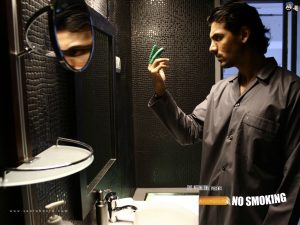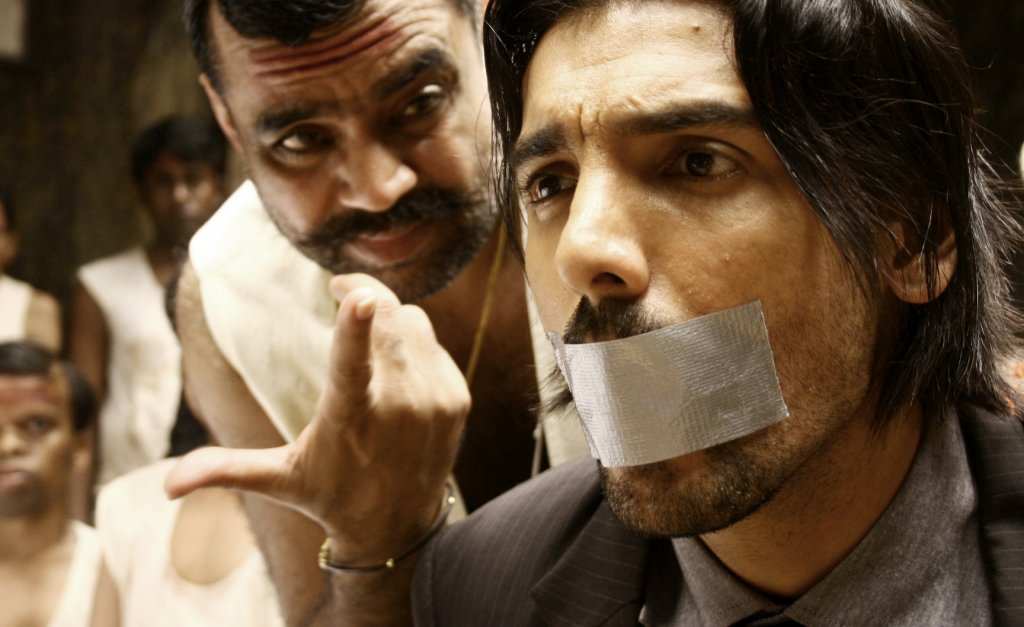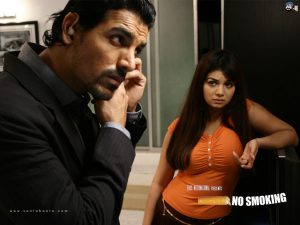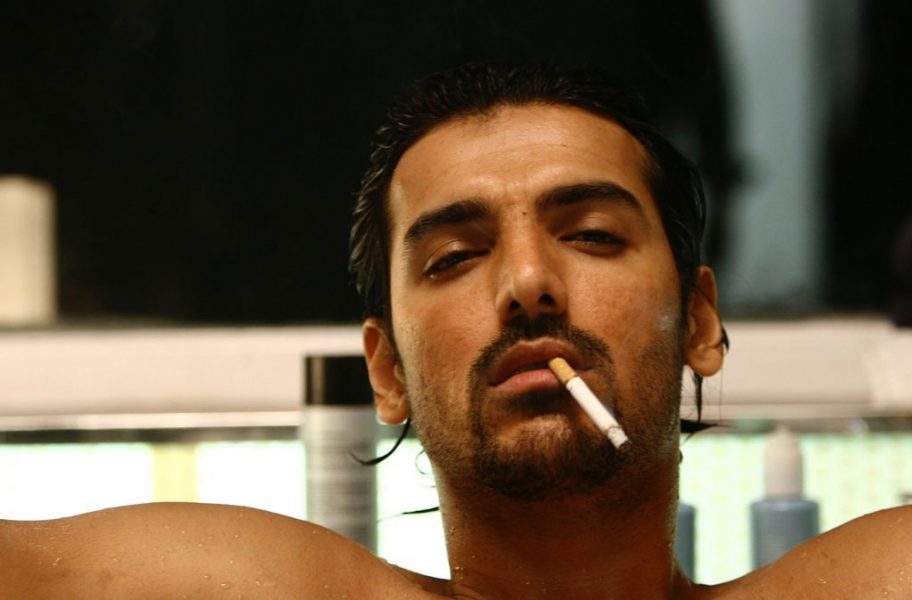The year was 2007. Akshay Kumar was ruling the box office with his slapstick comedies like ‘Singh Is Kinng’. Formulaic cinema was working wonders. That’s when India’s resident maverick Anurag Kashyap dared to release ‘No Smoking’, a surrealistic neo-noir psychological thriller based on a Stephen King short story named ‘Quitters Inc.’. Kashyap managed to give the story an Indian spin and created a genuinely baffling film. But it turned out to be a little too ahead of its time. While it received accolades overseas, neither critics nor audiences back home warmed up to it, which is a travesty. It is a divisive film, hailed by some as a Lynchian masterpiece and has garnered a niche fandom who marvel at its cryptic nature. while others bash it for making no sensible connection between its sequences and only existing to baffle its viewers.
Nonetheless, it is an intriguing film which requires some light to be thrown upon it. Fret not, in this piece, I try to explain the plot, meaning, symbolism and possible interpretations of the film. An obvious spoiler alert is necessary for the uninitiated.
The Plot

The basic plot goes like this: ‘K’ is a 30-something affluent, narcissistic, arrogant, Patrick Bateman-esque alpha male who is a little too addicted to the ol’ sutta. His wife Anjali chides him incessantly on this habit and wants him to quit. K’s friend Abbas, who lost his fingers in an apparent accident, and his doctor, whose mother is on her deathbed, offer to set up an appointment at a rehabilitation centre called ‘Prayogshaala’ (‘The Laboratory’), which they claim will surely rid K of his habit. After Anjali leaves him, unable to take the strain K’s addiction places on their relationship, K relents and decides to check out Prayogshala, an omniscient shadow organisation headed by Shri Shri Prakash Guru Ghantal Baba Bengali Sealdahwale (Paresh Rawal). The organisation uses fear and psychological manipulation. Each time a patient gives in to their urges, something heinous happens to them (which was what had happened to Abbas and the doctor).
The plotline gets blurry after both Arjun’s wife and brother die due to either his actual or perceived lack of control, and he wakes up in a Siberian army base, which is a familiar site of his nightmares. As he has already given into his vices thrice, his soul ends up being separated from his body (which, cryptically explained, is the punishment for smoking the fourth cig) and in a room full of ragged souls when he jumps into a bathtub in the middle of nowhere. After he sees his own (apparently soulless) body staring at him, unaware of his existence, his body goes through a series of haphazard events, after which he wakes up in his own bed, besides his wife, who’s very much alive, and missing two fingers, like Abbas. As the films ends, he’s seen convincing another friend to join Prayogshala.
The Possible Interpretations

The film opens with three quotes:
To do is to be – Socrates.
To be is to do – Plato.
Do be do be do – Sinatra
All three quotes have similar words, signifying the film is open to varied interpretations.
The bizarre plot opens the way for two interpretations: Is the core of the film a hallucination induced by Prayogshala? Or does it all happen in a fantasy-surrealistic world actually controlled by the powerful organisation? There is plenty of evidence supporting both the hypotheses. When K is shoved down a mysterious vent after he refuses to undergo the treatment, it is plausible that he was drugged and fed the whole bizarre storyline as part of a torture treatment, and that when Abbas referred K to the programme and received his ‘fingers’, it was a signal of the end of his addiction.
But the surreal ability of the organisation to cut and then rejoin fingers, the information about K available with them even before any physical contact with him (remember that tablet he put his hand on before he entered their den for the first time?) plus the discrete presence of the name ‘Calcutta Carpets’, which is Prayogshala’s front, at places like the hospital where K’s brother is admitted, underlines the influence of the mysterious organisation and thus support the latter hypothesis of Prayogshala indeed being an omniscient power.

Well, the actual meaning is a middle ground between these two interpretations, yet a lot different from the popular connotations about it. Director Anurag Kashyap, in a rediff live chat (because those were in fashion back then!), explained “When K falls into the water in the police station his soul and body go on two separate journeys. The soul is confused, tortured, doesn’t know what’s going on and then is burnt in hell. What wakes up is the body, finally calm because the internal torture has ended realises his fingers are cut, signifying the separation of his soul.” So the crux of ‘No Smoking’ is a journey of the subconscious, but not all of it is K’s imagination, as many theories online suggest.
Is ‘No Smoking’ just about smoking?

Well, duh, of course not. While on the surface, the film just deals with a man’s obsession with the smoke, it can be considered a commentary on any kind of addiction and a man’s fight with it, conscious as well as subconscious. But even that is pretty evident isn’t it?
But on a deeper level, the film can be perceived as the fight between the arrogant and the super-arrogant. Anurag Kashyap answered this very question, saying, “The story is actually between the freedom to choose and censorship. Smoking is bad but the motto is ‘Give me the freedom to choose’. The genesis was a Stehen King story, but my experiences with the two other films changed it to what it is”. While smoking (or making violent films) is injurious, is taking these measures to make people stop doing it moral? That is the question ‘No Smoking’ seeks to ask. Kashyap’s previous films ‘Paanch’ and ‘Black Friday’ had run into a truckload of trouble with the CBFC, which is what brought forth the idea of this film.
So, in a nutshell, ‘No Smoking’ is a commentary on the incessant censorship throttling the freedom of expression, wrapped in a smoking analogy. Deep, eh?
The Symbolism

‘No Smoking’ is littered with motifs which seem random at first but convey a deep meaning when mulled upon. Let’s shed some light on the symbolic meaning of some of the film’s recurring patterns:
The Two Missing Fingers – The two fingers which the Praypgshala chops off aren’t random; they’re your ‘smoking’ fingers. Literally cutting them signifies the extreme measure taken to cut one off. Kashyap explains in context to the theme we earlier discussed “Have you realised that the fingers we use to hold a cigarette is also used to hold a pen.. holding a pen symbolises writing that is freedom of expression, which is why Abbas, having lost his fingers had lost his soul.” Thus the fingers being cut are a strong allusion to the cutting off of the freedom of speech (another jab at censorship)
The Bathtub – The bathtub (or any water body) signifies the calm centre of K’s universe. It is the one place where he feels calm, and therefore is the place where his conscious and subconscious merge. As Kashyap explained, K’s journey becomes subconscious once he is submerged into the water at the police station. Except the end, where he emerges in a bed, K always emerges in a bathtub at the end of his subconscious trips.
The Siberian Army Base – The heavily-guarded Siberian army base, which troubles K in nightmares even before the encounter with Prayogshala, signifies an isolated, oppressive regime of control with the bathtub and a box of cigs, his two calming agents, visible in the distance.
Prayogshala being underground – This one’s pretty clear, as Paresh Rawal himself says it during the film. The lab being underground, at the end of a labyrinth-like path, signifies it being a kind of hell (or pataal lok) which, according to Hindu mythology, is under the ground we live upon.
The Hearing Aid – Everyone undergoing treatment with Prayogshala is seen wearing hearing aids. It signals ans that the patients, who were unwilling listeners at first to the detractors of their habit, were now listening clearly.
The ‘One Rupee Fees’ – According to Kashyap, the meagre fees is the is his version of ‘my two cents’ or the opinion put forth by the baba, as well as the significance of a small amount of effort.
Final Word
‘No Smoking’ is a truly surreal affair with many facets to it. However objective, the views above are influenced by my own psychological wiring. Your interpretation might differ vastly, which is the beauty of the film. Do tell me which parts of my analysis you agree with and which parts seem erroneous.
Read More: Andhadhun, Explained

